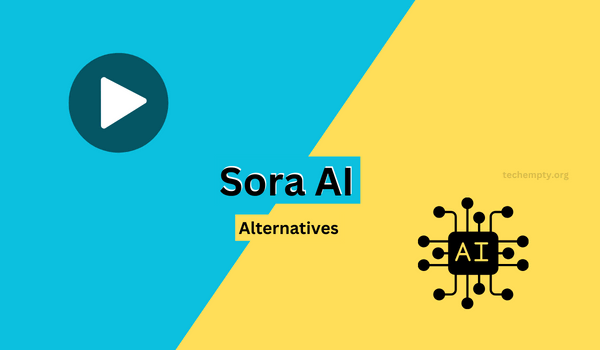As generative AI advances rapidly, creators like us have an expanding toolbox of AI-powered video creation platforms. One gaining lots of buzz is Sora from Anthropic, touted as a breakthrough in converting text prompts into nearly 1-minute realistic videos for imaginative scenes.
With Sora still in private beta, available details remain limited. So, how exactly does Sora compare right now to alternatives for AI video generation?
What are its key strengths and limitations in enabling creative projects?
We break things down in this post to highlight where Sora excels and falls short versus rival AI tools.
Start here..
Overview of Sora’s Capabilities
Let’s first recap Sora’s core capabilities based on what Anthropic has previewed. Sora takes freeform user prompts and generates up to 1080p video for around 50 seconds. Its visual quality matches professional human-filmed content. Using text instructions, Sora also provides tools to extend existing videos and animate still images.

Anthropic targets a 2023 public release for Sora after keeping it private to responsibly develop cutting-edge technology. More comprehensive access will still take time, though. Sora will have waiting lists and control commercial usage via monthly credits.
Sora AI Alternatives
Compared with Sora AI, the following are the best alternatives for text-to-video generation tools.
Compare Sora to Runway Gen-2
A rival gaining attention is Runway Gen-2 for video stylization and post-production. While Sora converts text to video, Runway Gen-2 specializes in editing and remixing footage.
Runway Gen-2 builds on RunwayML’s strength with image remixing – say, removing objects or people from a scene. Gen-2 expands its predecessor’s capabilities to handle multi-track video editing. This includes effects like slow motion and still image animation.
So, while Sora focuses on open-ended text-based editing to produce full videos, Runway Gen-2 enables tweaking and building on existing video transcripts. Runway’s specialized approach makes it ideal for creators doing many social media clips or professional presentations.
Contrast Sora with Google Lumiere & Meta Make-a-Video
Google and Meta (Facebook) have previewed text-to-video projects named Lumiere and Make-a-Video, respectively. These seem most directly comparable to Sora’s aim to convert text into full-fledged footage.
All 3 tools take freeform text prompts and generate video with no traditional filming required. However, Sora stands out in benchmarks shared so far – its videos run significantly longer in 1-minute durations with 1080p resolution.
Lumiere and Make-a-Video timeframes haven’t been disclosed publicly. Their output resolution also needs to be clarified. So, while their AI development may be promising, Sora appears further along regarding text-to-video capabilities.
Sora also uniquely provides advanced editing features within its interface to extend and animate videos. This further differentiates it from Lumiere and Make-a-Video as an integrated workspace for producers.
Differentiate Sora from DeepBrain AI Studios
DeepBrain AI Studios has a different focus than Sora and other text-to-video tools. Its specialty is crafting realistic human AI avatars that speak with accurate lip synchronization.
DeepBrain excels at replicating spokespeople and celebrities for dialog-driven content like educational videos or speeches. This precision requires extensive data and training to mimic individuals based on their mannerisms and voice.
By contrast, Sora visualizes free-flowing text without audio or spoken elements. Sora’s output emphasizes cinematic narratives rather than precise avatar mimicry. So DeepBrain outpaces Sora for realistic human-based videos, while Sora leads for imaginative movie-like content creation.
| Tool | Text-to-Video Generation | Video Length | Resolution | Audio/Speech | Avatar Mimicry | Image/Video Animation | Publicly Available |
| Sora | Yes | Up to 60 sec | Up to 1080p | No | No | Yes | No, expected 2024 |
| Google Lumiere | Yes | Undisclosed | Undisclosed | Unknown | No | No | No |
| Meta Make-a-Video | Yes | Undisclosed | Undisclosed | Unknown | No | No | No |
| Runway Gen-2 | No | N/A | N/A | No | No | Yes | Yes |
| DeepBrain AI Studios | No | N/A | N/A | Yes | Yes | No | Yes |
Highlight Sora’s Key Strengths
Given its stage of development, the Sora AI Video generator stands out from alternatives in these critical ways:
Generates up to 60-second 1080p videos from text – Its long-form high-res output exceeds what other text-to-video tools have demonstrated so far.
Can modify and animate existing videos – Sora uniquely enables the extension of footage and the animation of images within its interface.
Slated to launch publicly in 2024 – Unlike other projects in earlier testing, Sora already has a timeline for widespread commercial availability.
Discuss Sora’s Current Limitations
At the same time, Sora lacks some capabilities available from other tools:
No audio or speech generation – Sora focuses purely on visuals. DeepBrain AI Studios has far superior voice mimicry and lip synchronization for verbal content.
Requires heavy compute resources – Processing long videos with high resolutions demands extensive GPU power beyond most creators’ current setups.
Full potential remains untested – With Sora’s limited testing pool, techniques likely need to be developed more than public tools.
As Sora moves toward full commercial availability, pricing, and usage questions also remain unanswered:
- What will monthly credit costs be for generated videos?
- Will there be caps or filters on certain types of content creation?
- Who retains output ownership and IP rights on Sora videos?
Ongoing private development means Sora’s terms of use around these issues continue evolving.
Sora’s Positioning and Potential
Sora shows enormous promise as an emerging platform, pushing boundaries for imaginative scenes crafted from the text. It could become a go-to for everyone from indie creators to big production studios needing to mockup sequences or explore narrative pieces on tight budgets.
Sora won’t replace more specialized tools focused on tasks like realistic human avatar generation and dialogue-driven content. However, Sora outpaces any current text-to-video generation solution for open-ended visualizing events described in words.
The 2024 slated full release will shed more light on Sora’s commercial viability and any constraints around its application. For now, it remains a fascinating indicator of how quickly AI video creation continues progressing. Sora appears poised to shape many creative workflows as it becomes widely available to the public.

